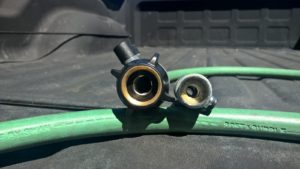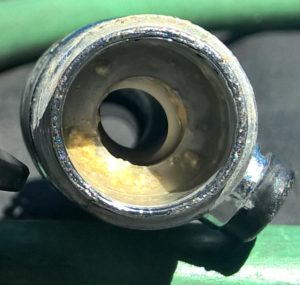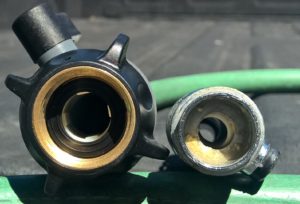I’ve always used a shutoff valve on the hose to my recycled water bladder so that when I’m done filling up I could have an easy way to seal the bag. When unloading, I would just open the valve when connected to my pump. Little did I know that valve was causing problems. The biggest part was I was choking my pump.
I was at home depot today and saw this garden hose shut-off valve with a “large water passage for enhanced flow rates” for garden hoses. It was $6.97. I brought it home and compared it to my metal shut off valve.
Upon unscrewing the hose from the valve I learned the valve never fully opened as it had built up salt deposits that were keeping it from moving. When bore sizes were compared, the new valve is much larger.
Would this have any impact on fill-up or unload?
I went to a recycled water fill station and tested it out. What usually took 10 minutes to fill a 150 gallon bladder now only took 5, cutting my fill time in half!
Once home, hooking everything up was much quicker as the new valve has a large area to grip when spinning the end onto the pump fittings. I set out my hoses and turned the pump on. I didn’t connect any flow restricting fittings to the other end of hose, like a lawn sprinkler.
There was a noticeable difference in flow pressure. Where-as before the stream from the hose would normally arc out 3-4 feet, it now arced 5-6 feet. Unload time was shorter. Before, it would take 20 to 25 minutes to unload, now it was down to 12 minutes.
My pump has a rated capacity of 25 gallons per minute, with a 12 minute unload time its moving 12.5 gallons per minute. A big increase from the 6-8 gallons a minute before.
The other noticeable difference was the sound the pump made. Before, when flow was choked down, water passing by the ball valve would make a grinding like sound – as tiny air bubbles were being introduced into the flow. With the new valve in place it was quiet, the pump no longer sounded like it was pumping rocks – a tell tale sign of cavitation. It definitely made it much smoother.
In sum, cavitation is the formation and subsequent collapse of vapor bubbles inside the pump. It occurs because the absolute pressure of the liquid falls beneath the liquids vapor pressure. When these bubbles collapse with enough frequency, it often sounds like marbles or rocks are going through the pump. If cavitation is severe enough, the bubbles can actually remove metal on pump surfaces, ruining the highly polished surfaces and leaving the pumps vulnerable to corrosion. – Holland Applied Technologies
So yes, changing the hose valve to a full bore isolation valve will decrease fill time to a water bladder and unload time. Better yet, it will reduce wear and tear on my pump.
For $6.97 from Home Depot, this is an easy DIY fix and one I highly recommend.







Leave a Reply